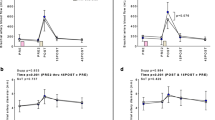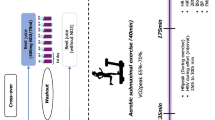Abstract
Introduction
Resistance exercise (RE) may lead to a post-exercise hypotension (PEH) response. Previous studies showed that green tea (GT) and its polyphenols, especially Epigallocatechin-3-gallate (EGCG) may have a favorable effect on blood pressure (BP).
Aim
We investigated the green tea extract (GTE) effects on BP, heart rate (HR), and rate pressure product (RPP) responses to a low-intensity RE in hypertensive women.
Methods
Middle-aged women (n = 24, 46.4 ± 6.3 years old; 66.6 ± 9.2 kg; 166.3 ± 4.2 cm) were randomly assigned into three groups of eight persons. GTE consumption group (T) and RE group (R), respectively, ingested GTE (~75 mg EGCG) and placebo (PL; maltodextrin) capsules two times a day for three weeks and then completed 2 circuits of six RE using 50% one repetition maximum (1RM). Patients of control group (C) just ingested PL and rested in a non-exercise control trial. BP, HR and RPP were measured prior and post-exercise at 0, 15, 30, 45, and 60 min.
Results
The repeated measures analysis of variance (ANOVA) revealed that there were no significant alterations for arterial BP, HR and RPP of C group. HR of T and R groups was increased immediately after RE. A significant fall of systolic BP (SBP) and diastolic BP (DBP) occurred in both T and R groups for 60 min post-exercise compared to resting values. Mean arterial BP (MAP) and RPP decreased significantly after RE in both exercise groups from 15 to 60 min. During 45 and 60 time points, T group had a lower RPP values than C group. The differences between T and R groups were only MAP at 0 and 15 time points.
Conclusions
Three weeks of GTE ingestion did not influenced SBP, DBP and HR but may be have a favorable effect on MAP and RPP responses to an acute RE during 1 h recovery of exercise.



Similar content being viewed by others
References
Thompson PD, Franklin BA, Balady GJ. Exercise and acute cardiovascular events placing the risks in to respective a scientific statement from the American heart association council on nutrition, physical activity, and metabolism and the council on clinical cardiology. Circulation. 2007;115(17):2358–68.
Kokubo Y, Kamide K, Okamura T, Watanabe M, Higashiyama A, Kawanishi K, et al. Impact of high-normal blood pressure on the risk of cardiovascular disease in a Japanese urban cohort: The suita study. Hypertension. 2008;52(4):652–9.
Iellamo F, Volterrani M. Effect of exercise training in essential arterial hypertension. Rev Bras Hipertens. 2010;17(2):68–71.
Fisher MM. The effect of resistance exercise on recovery blood pressure in normotensive and borderline hypertensive women. J Strength Cond Res. 2001;15(2):210–6.
Pescatello LS, Franklin BA, Fagard R, Farquhar WB, Kelley GA, Ray CA. American College of Sports Medicine, position stand: exercise and hypertension. Med Sci Sports Exerc. 2004;36(3):533–53.
Rodriguez D, Polito MD, Bacurau RFP, Prestes J, Pontes FL Jr. Effect of different resistance exercise methods on post-exercise blood pressure. Int J Exerc Sci. 2008;1(4):153–62.
Brown SP, Clemons JM, He Q, Liu S. Effects of resistance exercise and cycling on recovery blood pressure. J Sports Sci. 1994;12:463–8.
Halliwill JR. Mechanisms and clinical implications of post-exercise hypotension in humans. Exerc Sport Sci Rev. 2001;29:65–70.
Cornelissen VA, Fagard RH. Exercise intensity and post-exercise hypotension. J Hypertens. 2004;22(10):1859–61.
Cornelissen VA, Fagard RH. Effect of resistance training on resting blood pressure: a meta-analysis of randomized controlled trials. J Hypertens. 2005;23(2):251–9.
Lim DY, Lee ES, Park HG, Kim BC, Hong SP, Lee EB. Comparison of green tea extract and epigallocatechin gallate on blood pressure and contractile responses of vascular smooth muscle of rats. Arch Pharm Res. 2003;26(3):214–23.
Hodgson JM, Devine A, Puddey IB, Chan SY, Beilin LJ, Prince RL. Tea intake is inversely related to blood pressure in older women. J Nutr. 2003;133(9):2883–6.
Yang YC, Lu FH, Wu JS, Wu CH, Chang CJ. The protective effect of habitual tea consumption on hypertension. Arch Intern Med. 2004;164(14):1534–40.
Potenza MA, Marasciulo FL, Tarquinio M, Tiravanti E, Colantuono G, Federici A, Kim JA, Quon MJ, Montagnani M. EGCG, a green tea polyphenol, improves endothelial function and insulinsensitivity, reduces blood pressure, and protects against myocardial I/R injury in SHR. Am J Physiol Endocrinol Metab. 2007;292:1378–87.
Cabrera C, Artacho R, Giménez R. Beneficial effects of green tea—a review. J Am Coll Nutr. 2006;25(2):79–99.
Wolfram S. Effects of green tea and EGCG on cardiovascular and metabolic health. J Am Coll Nutr. 2007;26(4):373S–88S.
Nagle DG, Ferreira D, Zhou YD. Epigallocatechin-3-gallate (EGCG): chemical and biomedical perspectives. Phytochemistry. 2006;67:1849–55.
Chobanian AV, Bakris GL, Black HR, Cuschman WC, Green LA, Izzo JL, Jones DW, Materson BJ, Oparil S, Wright JT, Rocella EJ. Seventh report of the Joint National Committee on prevention, detection, evaluation, and treatment of high blood pressure. JAMA. 2003;289:2560–72.
Jackson AS, Pollock ML. Generalized equations for predicting body density of men. BJN. 1978;40:497–504.
Brzycki M. Strength testing-predicting a one-rep max from reps-to-fatigue. JOPERD. 1993;68:88–90.
Astorino TA, Martin BJ, Schachtsiek L, Wong K. Caffeine ingestion and intense resistance training minimize postexercise hypotension in normotensive and prehypertensive men. Res Sports Med. 2013;21(1):52–65.
Rezk CC, Marrache RC, Tinucci T, Forgaz CL. Post-resistance exercise hypotension, hemodynamics, and heart rate variability: influence of exercise intensity. J Appl Physiol. 2006;98:105–12.
Mohebbi H, Rahmani-Nia F, Sheikholeslami Vatani D, Faraji H. Post-exercise responses in blood pressure, heart rate and rate pressure product in endurance and resistance exercise. Medicina dello Sport. 2010;63(2):209–19.
Delavar SH, Faraji H. Effect of different concurrent training methods on post-exercise hypotension in borderline hypertensive women. MEJSR. 2011;9(4):456–61.
Boroujerdi SS, Rahimi R, Noori SS. Effect of high versus low-intensity resistance training on post-exercise hypotension in male athletes. Int Sport Med J. 2009;10:95–100.
Queiroz ACC, Gagliardi JFL, Forjaz CLM, Rezk CC. Clinic and ambulatory blood pressure responses after resistance exercise. J Strength Cond Res. 2009;23(2):571–8.
Faraji H, Nikookheslat SD. Effect of concurrent exercise on post-exercise hypotension in borderline hypertensive women: influence of exercise intensity. Kinesiology. 2012;44(2):166–72.
Melo CM, Alencar Filho AC, Tinucci T, Mion D Jr, Forjaz CL. Post-exercise hypotension induced by low-intensity resistance exercise in hypertensive women receiving captopril. Blood Press Monit. 2006;11:183–9.
Negishi H, Xu JW, Ikeda K, Njelekela M, Nara Y, Yamory Y. Black and green tea polyphenols attenuate blood pressure increases in stroke-prone spontaneously hypertensive rats. J Nutr. 2004;134:38–42.
Okushio K, Matsumoto N, Kohri T, Suzuki M, Nanjo F, Hara Y. Absorption of tea catechins into rat portal vein. Biol Pharm Bull. 1996;19:326–9.
Yang CS, Chen L, Lee MJ, Balentine D, Kuo M, Schantz SP. Blood and urine levels of tea catechins after ingestion of different amounts of green tea by human volunteers. Cancer Epidemiol Biomarkers Prev. 1998;7:351–4.
Wilcox RG, Bennet T, Macdonald IA, Broughton FP, Baylis PH. Post-exercise hypotension: The effects of epanolol or atenolol on some hormonal and cardiovascular variables in hypertensive men. Br J Clin Pharmacol. 1987;24:151–62.
Acknowledgments
We thank the patients participated in this study. We also thank authorities and personnel the Heshmat Cardiovascular Hospital of Guilan University of Medical Sciences for their assistance and cooperation in the use of cardiovascular equipment.
Author information
Authors and Affiliations
Corresponding author
Rights and permissions
About this article
Cite this article
Arazi, H., Samami, N., Kheirkhah, J. et al. The Effect of Three Weeks Green Tea Extract Consumption on Blood Pressure, Heart Rate Responses to a Single Bout Resistance Exercise in Hypertensive Women. High Blood Press Cardiovasc Prev 21, 213–219 (2014). https://doi.org/10.1007/s40292-014-0048-1
Received:
Accepted:
Published:
Issue Date:
DOI: https://doi.org/10.1007/s40292-014-0048-1




